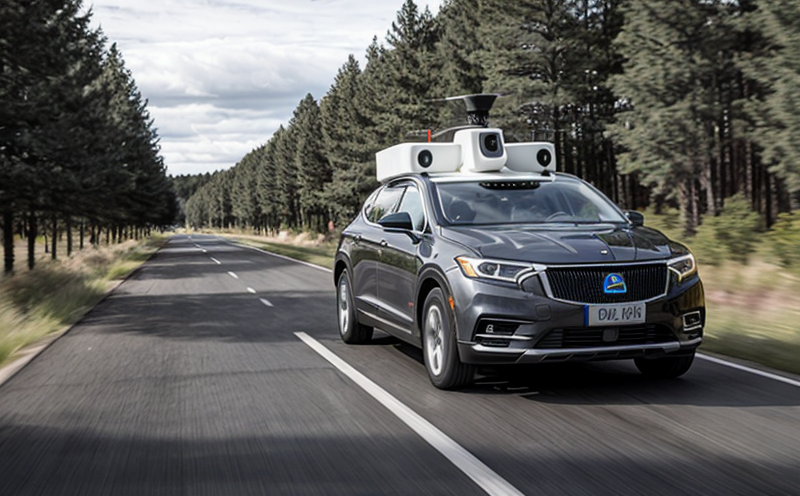ASTM F2562 Human Detection and Avoidance in Robot Navigation
The ASTM F2562 standard provides a framework for evaluating the performance of robots equipped with human detection and avoidance capabilities. This test is crucial as it ensures that autonomous systems can safely navigate environments where humans are present, reducing the risk of accidents or injuries. The ASTM F2562 protocol aims to validate whether robotic systems can detect the presence of pedestrians, cyclists, and other mobile objects in real-time and respond appropriately by adjusting their speed, direction, or even stopping.
The test is particularly important for industries such as manufacturing, logistics, healthcare, and retail. In these sectors, autonomous robots are increasingly being deployed to perform tasks that were previously done by humans. However, the safe coexistence of humans and robots requires rigorous testing to ensure that robotic systems can reliably detect human presence and avoid collisions.
The ASTM F2562 test involves a series of scenarios designed to simulate real-world conditions where robots may encounter pedestrians or other obstacles. These scenarios include:
- Walking individuals at different speeds
- Cyclists navigating through robot pathways
- Humans in various postures (sitting, standing, walking)
- Multiple humans moving simultaneously
In each scenario, the test assesses several critical parameters:
- Time taken to detect human presence
- Accuracy of detection
- Robustness against false positives/negatives
- Response time and effectiveness in adjusting speed or direction
- Ability to stop safely when necessary
The test requires precise instrumentation, including sensors such as LiDAR (Light Detection and Ranging), cameras, and ultrasonic sensors. These devices are calibrated according to the ASTM F2562 specifications to ensure consistent and accurate readings across multiple trials.
After conducting the tests, detailed reports are generated that document all key performance indicators (KPIs). These reports serve as evidence of compliance with the ASTM F2562 standard and provide valuable insights into the robotic system's capabilities. The data can be used by quality managers and R&D engineers to refine algorithms and improve overall system performance.
Compliance with the ASTM F2562 standard is not just a technical requirement; it also reflects an ethical responsibility towards ensuring public safety. By adhering to this standard, manufacturers of autonomous robots demonstrate their commitment to developing safe and reliable systems that can operate harmoniously in shared spaces with humans.
Industry Applications
The ASTM F2562 human detection and avoidance test is widely applicable across various industries where autonomous navigation is critical. Here are some key sectors:
- Manufacturing: Automated guided vehicles (AGVs) in warehouses and factories need to navigate around workers safely.
- Healthcare: Robotic assistants that help patients move within hospitals or nursing homes must avoid collisions with staff or visitors.
- Logistics: Drones and autonomous delivery robots used for last-mile deliveries should be able to detect pedestrians on sidewalks.
- Retail: Indoor navigation systems in large retail spaces can benefit from robust human detection capabilities to guide shoppers safely.
In each of these industries, the ability of robots to avoid humans is paramount. Failure to do so could lead to accidents, damage to equipment, or even legal liabilities. By ensuring compliance with ASTM F2562, companies can mitigate these risks and build trust with stakeholders.
Competitive Advantage and Market Impact
Compliance with the ASTM F2562 standard offers significant competitive advantages in the autonomous robotics market:
- Safety Leadership: Companies that meet this standard demonstrate a commitment to safety, which can enhance their reputation among customers.
- Regulatory Compliance: Adherence ensures that products comply with relevant international standards, facilitating smoother entry into global markets.
- Innovation: The test encourages continuous improvement in robotic technology, driving innovation and enhancing product features.
- Customer Confidence: Meeting such a stringent standard builds confidence among buyers who prioritize safety in their procurement decisions.
The market impact is also notable. As autonomous robotics becomes more prevalent across industries, demand for robust testing solutions like ASTM F2562 will grow. Companies that invest early in meeting these standards can position themselves as leaders in a rapidly evolving field.
Use Cases and Application Examples
- Factory Floor Robots: AGVs must detect workers moving through aisles to avoid collisions.
- Hospital Assistants: Robotic assistants should be able to sense the presence of nurses or patients in their path.
- Retail Drones: Indoor delivery drones need to navigate around customers and staff without causing accidents.
- Smart Homes: Robots designed for home automation can use human detection capabilities to avoid bumping into family members.
In each of these examples, the ability of the robot to detect and avoid humans is critical. The ASTM F2562 standard provides a structured approach to ensure that this capability meets industry expectations and safety requirements.





